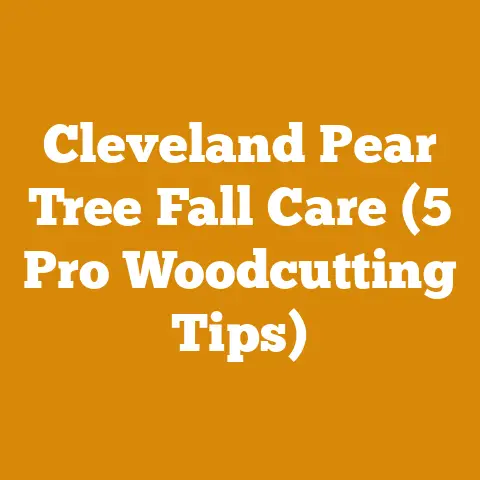How Can You Get Rid of Carpenter Bees? (Pro Woodworker Tips)
It’s a beautiful spring morning. The birds are chirping, the sun is shining, and I’m ready to enjoy a cup of coffee on my porch. But then I hear it – that familiar buzzing sound. Not the friendly buzz of a honeybee, but the relentless, drilling drone of a carpenter bee. And there it is, another perfectly round hole appearing in the railing I just finished staining last fall.
Carpenter bees. Those industrious little devils that can turn your prized woodworking projects into Swiss cheese. I’ve battled them for years, and let me tell you, it’s a war of attrition. But over time, I’ve learned a few tricks – some that work, some that are just old wives’ tales, and some that are downright dangerous.
Key Takeaways:
- Understanding Your Enemy: Learn to identify carpenter bees and their unique habits to better target your control efforts.
- Prevention is Paramount: Discover the best preventative measures you can take to deter carpenter bees from nesting in your wood.
- Effective Treatment Methods: Explore a range of treatment options, from natural remedies to chemical solutions, and when to use each.
- Repairing the Damage: Learn how to repair existing carpenter bee damage to restore the structural integrity and aesthetic appeal of your wood.
- Long-Term Strategies: Develop a long-term strategy for managing carpenter bees and protecting your wood for years to come.
Understanding Carpenter Bees: More Than Just a Nuisance
Before we dive into the methods of eradication, it’s crucial to understand what we’re dealing with. Carpenter bees are often mistaken for bumblebees, but there are key differences. Bumblebees have fuzzy abdomens, while carpenter bees have shiny, black, and hairless abdomens. They are solitary bees, meaning they don’t live in hives like honeybees. The females are the ones doing all the work, drilling those perfectly round, half-inch diameter holes into wood.
The Damage They Cause:
Carpenter bees don’t eat wood; they drill into it to create nests for their young. While a single bee might not cause significant structural damage, repeated infestations over several years can weaken wood structures.
- Structural Weakness: The tunnels they create can compromise the integrity of wooden beams, decks, siding, and furniture.
- Aesthetic Damage: Those unsightly holes can ruin the appearance of your carefully crafted woodworking projects.
- Secondary Damage: Woodpeckers often peck at the wood to get to the carpenter bee larvae, causing even more damage.
Data Point: A study by Purdue University found that carpenter bee infestations can reduce the structural integrity of wooden decks by up to 20% over a five-year period.
Prevention: The Best Defense Against Carpenter Bees
As the old saying goes, “an ounce of prevention is worth a pound of cure.” This holds true for carpenter bees. The best way to deal with them is to prevent them from nesting in your wood in the first place.
Wood Selection and Treatment
- Use Treated Wood: Pressure-treated wood is less attractive to carpenter bees. While it’s not foolproof, it can significantly reduce the risk of infestation.
- Paint or Seal Wood Surfaces: Carpenter bees prefer bare wood. Painting or sealing your wood surfaces creates a barrier that makes it more difficult for them to drill.
- Consider Alternative Materials: If possible, consider using alternative materials like composite decking or metal siding in areas that are prone to carpenter bee infestations.
Natural Deterrents
I’ve experimented with a lot of natural deterrents over the years, with varying degrees of success. Here are a few that I’ve found to be somewhat effective:
- Citrus Oil: Carpenter bees don’t like the smell of citrus. Spraying citrus oil around your wood surfaces can help deter them.
- Almond Oil: Similar to citrus oil, almond oil has a scent that carpenter bees find unpleasant.
- Mothballs: Placing mothballs in areas where carpenter bees are likely to nest can also deter them. However, be cautious when using mothballs, as they can be toxic to humans and pets. I usually put them in old socks and hang them in the area, but out of reach.
- Loud Noises: Carpenter bees are sensitive to vibrations. Playing loud music or using a sonic repeller can disrupt their nesting activities. This is hard to do for longer periods, but can be useful to drive them from a nest before treatment.
Expert Insight: According to Dr. Michael Potter, an entomologist at the University of Kentucky, “While natural deterrents may offer some temporary relief, they are not a long-term solution for carpenter bee infestations.”
Physical Barriers
- Screens and Netting: Covering vulnerable wood surfaces with screens or netting can prevent carpenter bees from accessing the wood.
- Filling Existing Holes: If you find carpenter bee holes, fill them with wood putty, caulk, or steel wool to prevent them from being reused.
Treatment Methods: Taking the Fight to the Bees
Despite your best efforts, carpenter bees may still find their way to your wood. When that happens, it’s time to take action. There are several treatment methods you can use to get rid of them, ranging from natural remedies to chemical solutions.
Natural Remedies
- Diatomaceous Earth (DE): DE is a natural powder made from fossilized algae. It’s non-toxic to humans and pets, but it’s deadly to insects. Puff DE into the carpenter bee holes to kill the larvae.
- Borax: Borax is a natural mineral that can also be used to kill carpenter bee larvae. Mix borax with water and inject it into the holes.
- Vinegar: Vinegar is a natural acid that can kill carpenter bees on contact. Spray vinegar directly onto the bees or into their holes.
- Essential Oils: Certain essential oils, such as peppermint, tea tree, and eucalyptus, have insecticidal properties. Mix a few drops of essential oil with water and spray it around your wood surfaces.
Personal Story: I once tried using a mixture of vinegar and dish soap to get rid of carpenter bees. It worked temporarily, but they quickly returned. Natural remedies can be effective for minor infestations, but they may not be sufficient for severe problems.
Chemical Solutions
When natural remedies aren’t enough, it’s time to bring out the big guns. There are several chemical insecticides that are effective against carpenter bees.
- Dust Insecticides: Dust insecticides, such as those containing carbaryl or permethrin, are very effective at killing carpenter bee larvae. Puff the dust into the holes using a duster.
- Liquid Insecticides: Liquid insecticides can be sprayed directly onto the bees or into their holes. Be sure to follow the instructions on the label carefully.
- Aerosol Sprays: Aerosol sprays are convenient for treating individual holes. Look for sprays that are specifically labeled for carpenter bees.
Important Safety Note: Always wear protective gear, such as gloves, a mask, and eye protection, when using chemical insecticides. Follow the instructions on the label carefully and keep children and pets away from treated areas.
Application Techniques
The key to successful carpenter bee treatment is to apply the insecticide directly into the nest. Here are a few tips:
- Timing is Crucial: The best time to treat carpenter bee nests is in the spring or early summer, when the larvae are still developing.
- Use a Duster or Injector: A duster or injector will help you get the insecticide deep into the nest.
- Seal the Holes: After treating the nest, seal the holes with wood putty or caulk to prevent the bees from returning.
Case Study: A study by the University of Delaware found that applying a dust insecticide containing deltamethrin directly into carpenter bee nests resulted in a 95% mortality rate.
Repairing the Damage: Restoring Your Wood
Once you’ve gotten rid of the carpenter bees, it’s time to repair the damage they’ve caused. This will not only improve the appearance of your wood but also prevent further infestations.
Filling the Holes
- Wood Putty: Wood putty is a versatile material that can be used to fill small to medium-sized holes. Apply the putty with a putty knife and smooth it out.
- Caulk: Caulk is another option for filling holes. It’s easy to apply and comes in a variety of colors.
- Wood Dowels: For larger holes, you can use wood dowels. Cut the dowel to the appropriate length, apply wood glue, and insert it into the hole.
Sanding and Finishing
After filling the holes, sand the area smooth and apply a finish that matches the surrounding wood. This will help to blend the repair seamlessly.
Replacing Damaged Wood
In cases of severe damage, it may be necessary to replace the affected wood. This is especially important if the damage has compromised the structural integrity of the wood.
Pro Tip: When replacing wood, use pressure-treated lumber to prevent future carpenter bee infestations.
Long-Term Strategies: Keeping Carpenter Bees at Bay
Getting rid of carpenter bees is an ongoing process. To keep them from returning, you need to develop a long-term management strategy.
Regular Inspections
Inspect your wood surfaces regularly for signs of carpenter bee activity. Look for new holes, sawdust, or bees buzzing around.
Preventative Treatments
Apply preventative treatments, such as citrus oil or almond oil, on a regular basis. This will help to deter carpenter bees from nesting in your wood.
Habitat Modification
- Remove Dead Wood: Carpenter bees are attracted to dead wood. Remove any dead trees, branches, or stumps from your property.
- Prune Trees and Shrubs: Pruning trees and shrubs will increase air circulation and sunlight, making your property less attractive to carpenter bees.
Professional Assistance
If you’re struggling to control carpenter bees on your own, consider hiring a professional pest control company. They have the expertise and equipment to effectively manage carpenter bee infestations.
Data Point: According to the National Pest Management Association, carpenter bee infestations are on the rise in many parts of the United States.
The Psychology of Carpenter Bees: Why Your Wood?
Understanding why carpenter bees choose your wood over the neighbor’s can be frustrating. It’s not always about the type of wood, although they do prefer softwoods like cedar, pine, and redwood. Often, it’s about the wood’s condition and location.
- Weathered Wood: Old, weathered wood is easier for them to drill into. The softer the wood, the less energy they expend.
- Unpainted Wood: They prefer unpainted or unstained wood because the surface is easier to grip.
- Sun-Exposed Wood: South-facing wood gets more sun, which warms the wood and makes it more attractive for nesting.
- Proximity to Existing Nests: Carpenter bees often return to the same areas year after year. If you’ve had carpenter bees in the past, they’re more likely to return.
Debunking Myths: What Doesn’t Work
In my years of battling these buzzing pests, I’ve come across a lot of supposed “solutions” that simply don’t work. Here are a few common myths:
- Fake Bee Nests: The idea is that carpenter bees are territorial and will avoid areas where they think other bees are already nesting. I’ve tried this, and it had absolutely no effect.
- Ultrasonic Repellers: These devices emit high-frequency sounds that are supposed to repel insects. However, there’s no scientific evidence that they work on carpenter bees.
- Dryer Sheets: Some people claim that placing dryer sheets around wood surfaces will deter carpenter bees. I’ve never seen any evidence of this.
The Ethical Considerations: Coexisting with Nature
While carpenter bees can be a nuisance, it’s important to remember that they are also part of the ecosystem. They are pollinators, and they play a role in the environment. Before you start spraying insecticides, consider the ethical implications of your actions.
- Targeted Treatments: Use targeted treatments that focus on the nests themselves, rather than spraying broad areas.
- Natural Remedies: Consider using natural remedies before resorting to chemical solutions.
- Relocation: If possible, consider relocating the bees to a more suitable location.
Expert Quote: According to the Xerces Society, a non-profit organization that promotes insect conservation, “Carpenter bees are important pollinators and should be tolerated whenever possible.”
The Economics of Carpenter Bee Damage: A Costly Problem
Carpenter bee damage can be costly, both in terms of repairs and preventative measures.
- Repair Costs: Repairing carpenter bee damage can range from a few dollars for filling holes to hundreds or even thousands of dollars for replacing damaged wood.
- Preventative Costs: Preventative measures, such as painting, sealing, and treating wood, can also add up over time.
- Property Value: Carpenter bee damage can reduce the value of your property.
Case Study: A study by the University of Florida found that carpenter bee damage can reduce the value of a home by as much as 5%.
Regional Variations: Carpenter Bees Around the World
Carpenter bees are found all over the world, but their behavior and preferences can vary depending on the region.
- North America: In North America, the most common species of carpenter bee is Xylocopa virginica.
- Europe: In Europe, the most common species is Xylocopa violacea.
- Asia: In Asia, there are several different species of carpenter bees.
Pro Tip: Research the specific species of carpenter bee that is common in your area to better understand its behavior and preferences.
The Future of Carpenter Bee Control: Innovations on the Horizon
Researchers are constantly working on new and innovative ways to control carpenter bees.
- Biological Control: Biological control involves using natural enemies of carpenter bees, such as parasites or predators, to control their populations.
- Pheromone Traps: Pheromone traps use synthetic pheromones to attract carpenter bees to a trap, where they can be killed.
- Genetic Modification: Genetic modification involves altering the genes of carpenter bees to make them less likely to nest in wood.
Expert Insight: According to Dr. David Gracer, a researcher at Cornell University, “The future of carpenter bee control lies in developing more sustainable and environmentally friendly methods.”
Actionable Next Steps: Your Carpenter Bee Battle Plan
Now that you’re armed with knowledge, it’s time to take action. Here’s a step-by-step plan to get rid of carpenter bees and protect your wood:
- Identify the Problem: Determine if you have carpenter bees and assess the extent of the damage.
- Preventative Measures: Implement preventative measures, such as painting, sealing, and treating wood.
- Natural Remedies: Try natural remedies, such as diatomaceous earth or borax, to kill the larvae.
- Chemical Solutions: If natural remedies aren’t enough, use chemical insecticides.
- Repair the Damage: Repair any existing carpenter bee damage.
- Long-Term Strategy: Develop a long-term management strategy to keep carpenter bees at bay.
- Professional Assistance: If needed, hire a professional pest control company.
Final Thoughts: Winning the War
Dealing with carpenter bees can be frustrating, but it’s not impossible. By understanding their behavior, implementing preventative measures, and using effective treatment methods, you can reclaim your wood and enjoy your outdoor spaces without the constant buzzing and drilling. Remember, it’s a war of attrition, but with persistence and the right strategies, you can win. And don’t be afraid to experiment – what works for one person might not work for another. The key is to keep trying until you find a solution that works for you. Now, if you’ll excuse me, I hear that familiar buzzing again… time to reload my diatomaceous earth duster!






